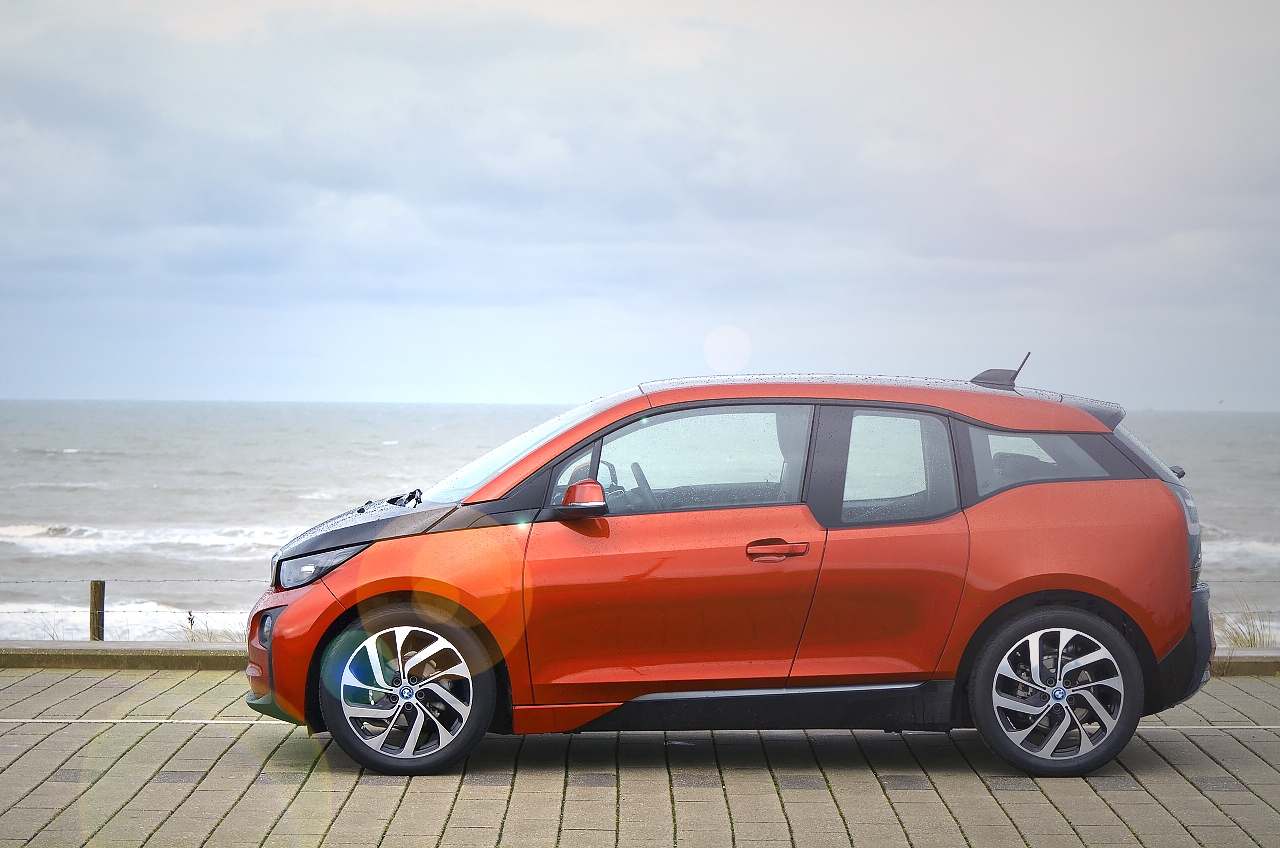
The future’s bright… the future’s orange. BMW’s i3 has been designed from the ground up to answer many of the criticisms levelled at electric vehicles but has it succeeded in producing a car you could live with everyday? Over the years I’ve been fortunate enough to have brought home all manner of BMWs but nothing I’ve ever parked up in my street has attracted so much attention as the i3 Range Extender that has recently passed through my hands. God only knows what my neighbours will make of it if I’m ever lucky enough to get an i8 on test, but the i3 stuck out amongst the bland offerings from mainstream manufacturers like a piece of fillet steak at a vegetarian barbecue. Neighbours I’d hardly ever spoken to came out to see it and I don’t think it’s any exaggeration to say that there must have been several occasions where there were a group of eight or ten people standing around it discussing its merits.
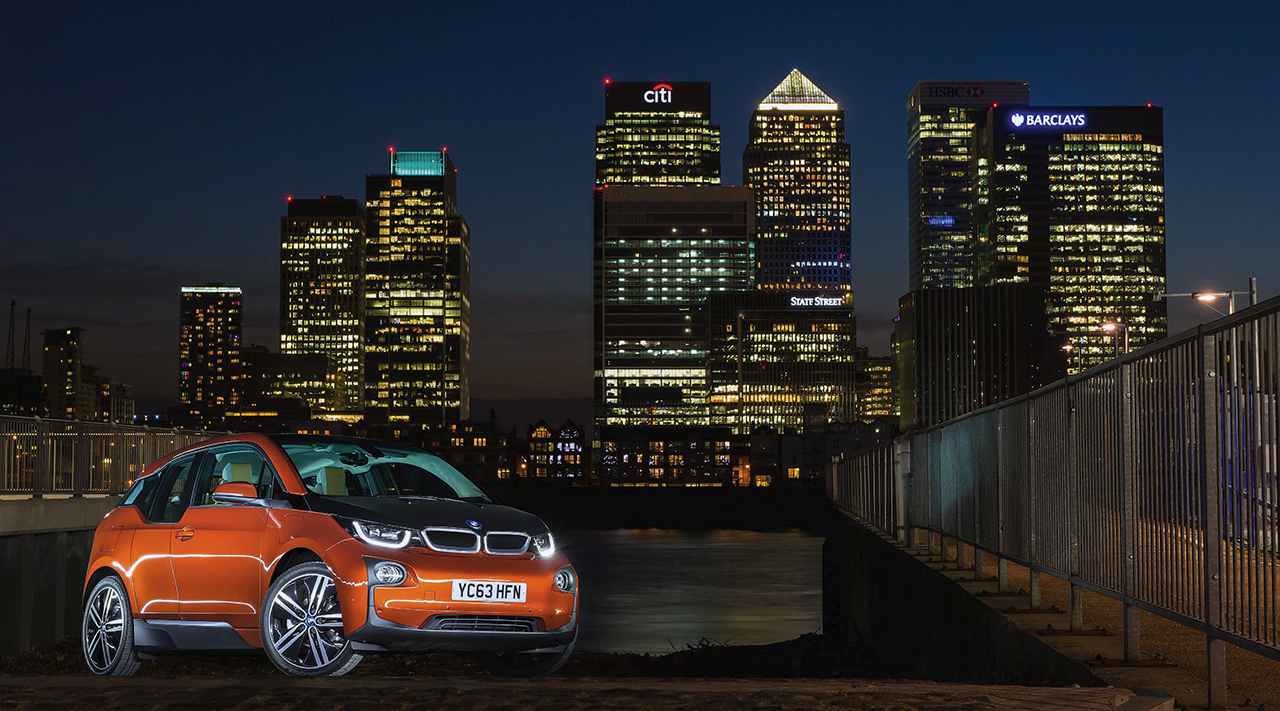
Spending time with an i3 does make you feel a little bit like you’ve just stepped out of Doc’s DeLorean from the Back to the Future films and it’s certainly the case that i3 ownership won’t be for shrinking violets until they become more of a regular sight on our roads. If I was given a pound for every time someone stopped and pointed at the i3 during my week’s custodianship I’d be a very rich man.
Being the object of attention is all well and good, but the real test for the BMW i3 would be whether it could be a practical proposition as my everyday transport. I didn’t want to go into the test of the i3 with too many preconceptions about what it was going to be like so I avoided looking back at previous road tests and didn’t search out local charging stations and the like. When I slipped behind the wheel of this Solar orange example at BMW’s Bracknell HQ I was immediately hit by a number of thoughts, most of them centred around the way it looks and the quality and style of the interior. I think it’s fair to say that the i3 isn’t a thing of beauty; distinctive, yes; pretty, no. What it does do is stand out like a sore thumb, and while the orange hue does allow for a corny headline, personally I think I’d be opting for a silver one if I were signing on the dotted line.
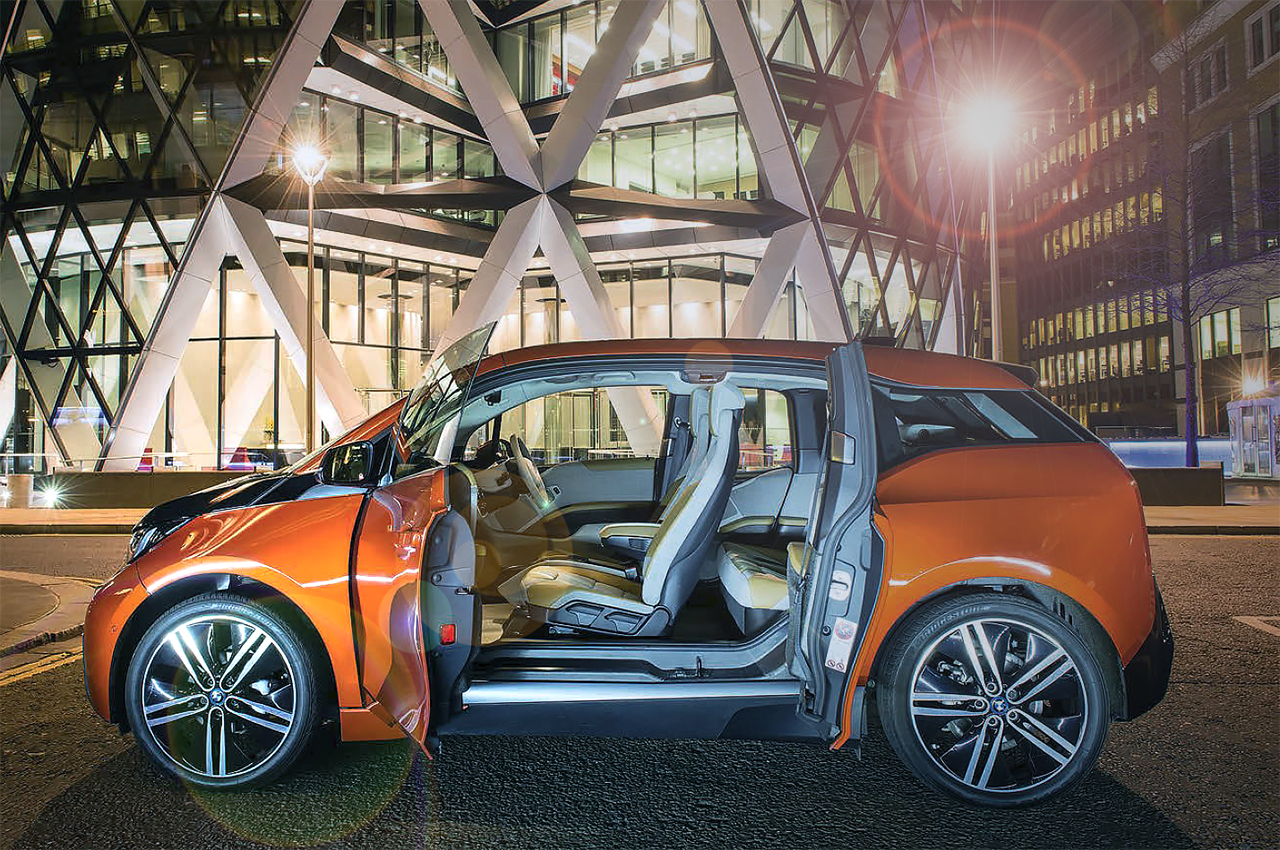
Opening the door shows that BMW isn’t a one-trick pony when it comes to interiors – the current range of its conventional machinery could be accused of being a little bit samey – but the i3 is a completely new direction for the company. Thanks to the car’s construction with its Life module (basically the upper half) and the Drive module (the bottom bit) BMW could start with a blank sheet of paper and as a result the cockpit of the i3 is refreshingly different. The first thing that strikes you is the lack of a transmission tunnel which gives the car a really open and inviting feel, and that’s closely followed by your second impression – there are an awful lot of different surfaces and textures here.
It’s entirely possible that the array of materials used in the interior could have led to an uncomfortable mishmash of surfaces but after a few minutes acclimatisation it gels together rather well. From the carbon structure of the car you can see running along the sills and up the A- and C-pillars to the eucalyptus wood on the dash, the naturally dyed leather trim sections, the wool woven seats and the parts of the dash and door trims made from fibres from the kenaf plant, the i3’s interior has been constructed from as many sustainable sources as possible and fits in perfectly with the car’s green ethos.
It might seem strangely at odds with the i3’s eco-interior trims but inside the car it feels very hi-tech thanks to the lack of traditional instrumentation and the two standard rectangular display screens. These supply you with a plethora of information and hidden features and delving into the different menus could keep you occupied for hours. However, the i3’s first task is to transport me the 55 miles back to Sevenoaks, mainly around the M25 so it will have its work set out as this type of a drive really isn’t what the i3 was designed for.
You don’t really notice ‘starting’ the i3 as pressing the start/stop button merely brings some additional lights onto the display panels and the word ‘Ready’ indicating that you’re good to go. The ‘gear selector’
(it only has two: forward and reverse) is sited on a chunky stalk to the right of the steering wheel (that also has the start button and a ‘P’ for ‘park’ button) and you twist it forward to engage drive and back towards you for reverse. For some reason I initially found this counter-intuitive, but by the end of the week my little brain had finally got to grips with which way to twist it. Once you’ve engaged drive it’s foot on the brake, release the handbrake (by pressing the button between the seats), foot off the brake, and… nothing. It doesn’t creep like a traditional auto, and as there’s no engine noise you initially aren’t sure if you’re really ready to go. Tickle the accelerator pedal and you’re in motion in virtually utter silence. It’s an odd sensation.
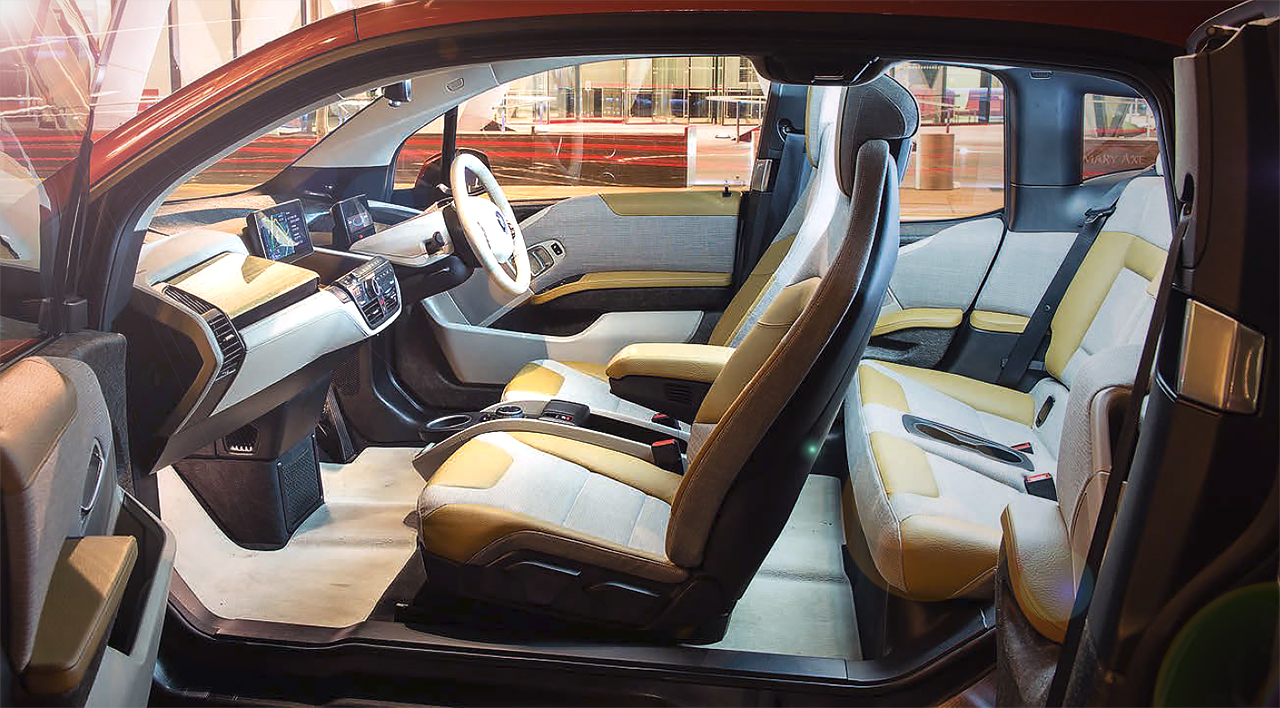
Interior dares to be different and is very successful in its use of a range of sustainable materials; dash layout very clear and twin-screen setup provides you with all the information you could need; not 100 per cent sold on the off-white steering wheel though and would probably opt for an alternative trim level.
Similarly odd is the way the i3 seems to want to stand on its nose the second you come off the throttle – its brake energy recuperation effect (which uses the electric motor in reverse to charge the lithium-ion battery) taking a little getting used to. The first few hundred meters or so come in a series of jerky manoeuvres as I get used to the instant torque, brisk acceleration and the brake energy regeneration, but after a couple of roundabouts driving the i3 in a different manner to a conventional vehicle becomes second nature. And what becomes immediately apparent is that it’s a lot of fun, too.
‘My’ i3 is the Range Extender version which means it has a 647cc twin-cylinder engine to charge the battery should the need arise, and the additional weight this brings (an extra 120kg) does take the edge off the i3’s acceleration figures (7.9 seconds versus 7.2 for the purely electric version) but it still feels hugely quick racing between roundabouts on
the run-up to the motorway, and as power delivery is utterly seamless and there are no gears to blunt your progress it feels significantly quicker than the 7.9- second figure would suggest. Chucking it in to a few corners also demonstrates that it’s going to be fun to punt along a back road, too – the low centre of gravity leading to a very neutral cornering attitude.

Around town the i3 has few, if any, peers; optional 20-inch rims do give it a slightly jiggly ride over some surfaces.
Using the car’s full performance in this way is certainly entertaining but it also doesn’t do any favours to the i3’s range and the distance that can be covered from its full charge has plummeted from an indicated 90 miles to 70 within a few miles. Hitting the motorway and keeping the throttle planted until I’m dicing with traffic in the outside lane at an indicated 80mph sees the range drop a little further but it soon settles into what turns out to be a more realistic and accurate range figure based on the way the car’s being driven.
I know that motorway driving and covering large distances aren’t really meant to be the i3’s forte but it does a really good job of it – it’s eerily quiet with very little road and wind noise, and despite my car being fitted with the optional 20-inch alloys it rides really rather well, too. Once I’ve established that it can cope with life in the fast lane I notch the pace back a tad and settle into a 60-65mph cruise and take in my surroundings, and start prodding a few switches and exploring iDrive sub menus.
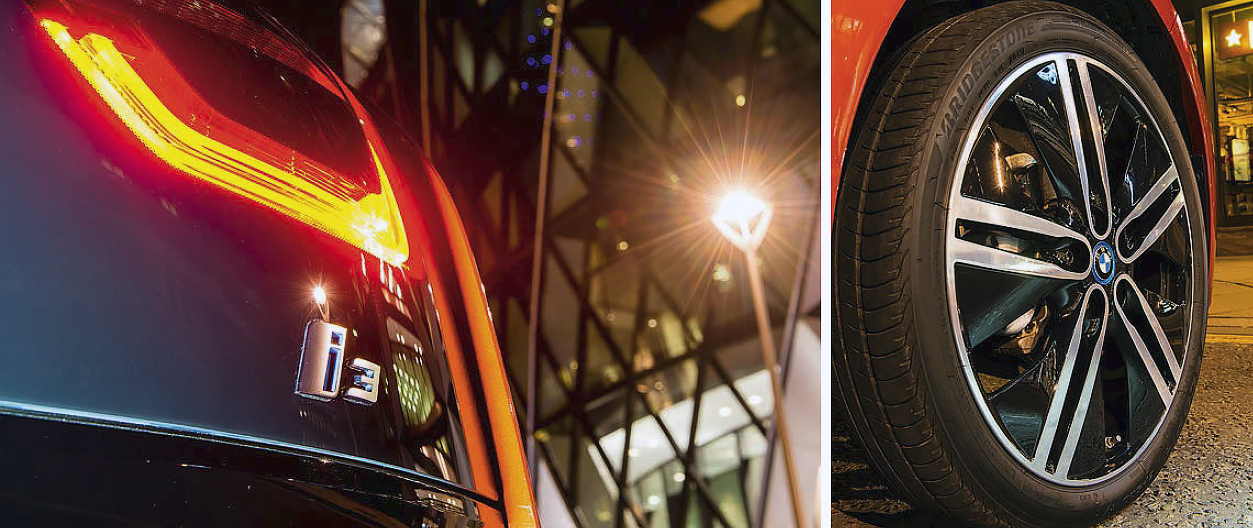
Like other BMWs the i3 has a switch to flick from Comfort to Eco Pro mode, but in the i3’s case there’s no Sport mode and as well as Eco Pro there’s also an Eco Pro+ mode which is designed to eke as much range as possible from the battery. So far I’ve only used Comfort mode and switching to Eco Pro doesn’t seem to affect the drive much other than extending the range by about three or four miles and slightly dulling throttle response. Eco Pro+ on the other hand sees the dash pod urging you to slow down via a series of mildly irritating (but no doubt effective) blue warning symbols and it switches off the air-con and electric seats too, and sees the electric range increase by another few miles. I did really like the way that the sat nav display shows you the range by shading the area you can reach, and switching to one of the Eco modes adds another blue shaded section showing the additional range.
Having safely reached the office with 20 miles of range left I elect not to plug the i3 in to charge for the afternoon as I’m keen to see if it will manage to get me to the end of my 21-mile commute home. To give it the best chance of achieving this I go with Eco Pro+. It’s neither hot not cold so I can manage without air-con and heated seats – and while it’s not quite as much fun to drive in this mode with its dulled throttle response it still pulls away from rest with gusto and can surprise with its pace. In the event the i3 completes my commute with range to spare – pootling into London in slow-moving traffic obviously is far less of a draw on the battery than bombing down the motorway and in the end there’s still 15 miles left by the time I park up at home.
I’ve hit the Holy Grail though and managed to park the i3 right outside my house – this is a rare once-a- week event and is huge cause for celebration as it means I’ll be able to charge the i3 overnight. This is the biggest drawback with the car as you really need to have your own off-street parking to make it a viable proposition as while I like the idea of an EV the fact that for 95 per cent of the week I can’t park close enough to my house to charge it makes ownership a real no-no. Charging is a doddle, though, using the supplied charger and cable and I’ve soon got it hooked up to the electricity supply and see the reassuring blue glow around the charging point to say that it’s doing its stuff. There is a slight concern that some nasty oik will come and unplug it but after reading the owner’s manual it transpires that as soon as the car’s charging the cable is locked in place and cannot be removed. Once the car’s charging you can see on the dash display the projected time it will take to be fully juiced up, and if you want to check on its progress at any time you can press the lock button on the key and the dash display will re-illuminate to show the current state of charge that you can look at through the window without having to open the door.
For the next few days the i3 trundles to and from the office and only requires the occasional charge… which unfortunately requires running an extension cable out of our first floor office window down to the car park, but it still works effectively. A full charge takes around eight hours from a domestic 13 amp source, but if you owned an i3 you’d obviously have a BMW i Wallbox installed (either at work or home, probably the latter depending on your circumstances) which supplies a 32 amp charge and will replenish the i3’s battery in around three hours. On a standard domestic tariff BMW reckons a full charge would cost £21 a month (based on 8000 miles a year) and if you take advantage of a cheaper Economy 7 Tariff that would lower to just £9.
Eventually the desire to see how the i3 runs with its Range Extender (RE) motor running leads me to run it low on battery and with four miles left on the electric range the RE kicks in to life and supplies charge to the battery. It’s important to note that the RE will only hold the battery’s state of charge – it won’t recharge it like plugging the car in – but the RE itself is well insulated and if you have the radio on you’re unlikely to really notice it in operation. It doesn’t operate when you’re stationary and if you concentrate you can just about feel it kicking in and out, particularly when decelerating. If you’re likely to tackle any lengthy journeys the best way to approach them is to let the battery deplete to 75 per cent charge and then turn the RE on via the iDrive. This way the i3 will always have the required gusto to maintain high-speeds on the motorway or to deal with long motorway inclines which it may not be capable of doing with a depleted battery and the RE motor running.
As well as sampling the RE and domestic charging options in the interest of completeness I also tried using a public charging point which I found using the sat nav which shows where all the ChargeNow points are located and whether they’re in use or not. Fortunately there was one just down the road from my house so when I took my son to the opticians (sadly he’s inherited my poor eyesight as well as my dashing good looks!) we went and tried it out and it was very simple to use. Initially there was some consternation that when I swiped my card on the reader and opened the flap it was only a 13 amp three pin socket that was exposed, but reading the instructions on the machine meant I had to simply wait a few more seconds for the fast charger flap to open. An hour later and it had gained about 35 miles- worth of electricity so BMW’s three hours for a full charge seems about spot-on.
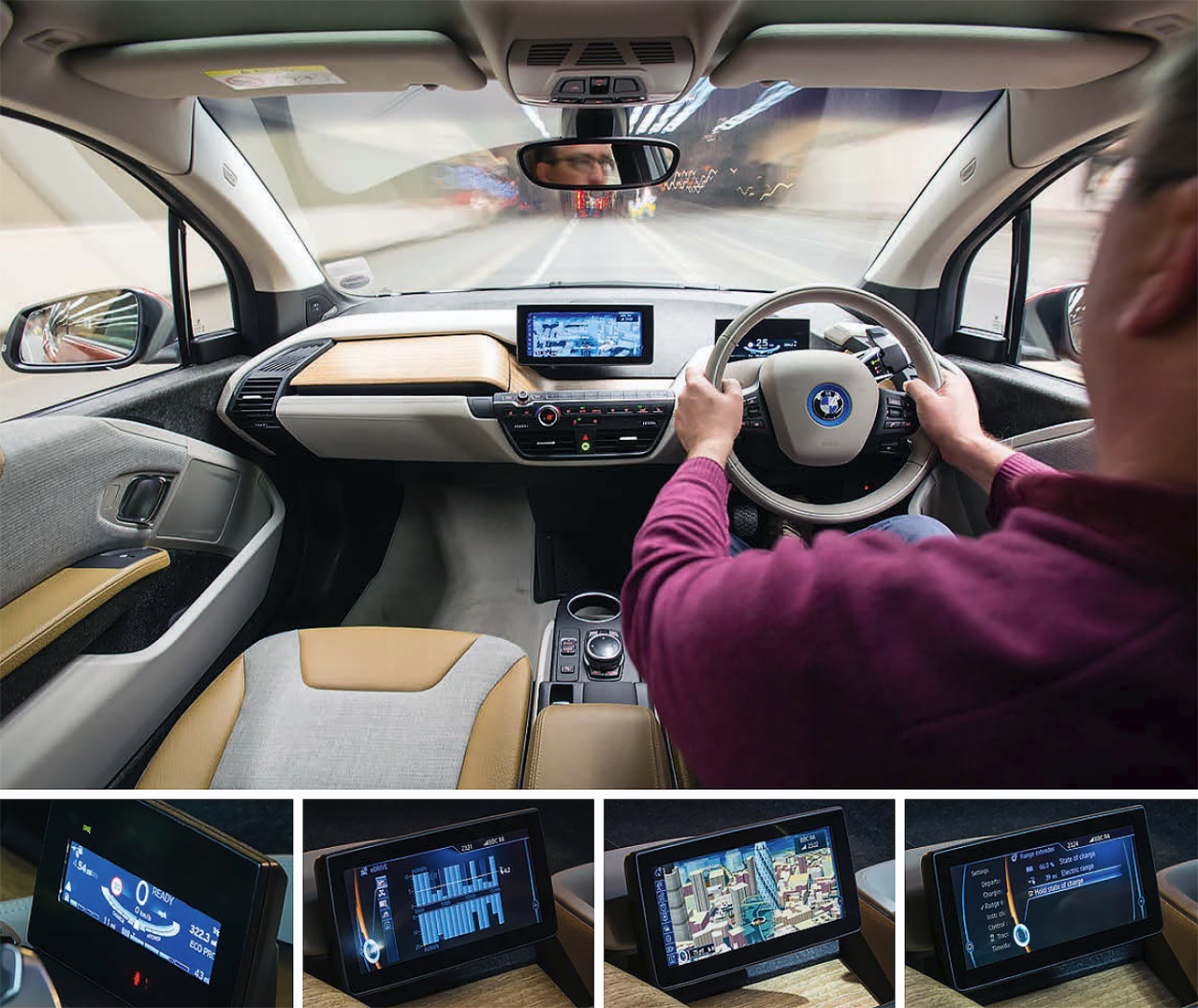
Top: Punting the i3 around London is an absolute blast and you’ll find the smallest excuse to take it for a drive. Display screens can show everything from electric range, RE range and combined range to driving style, sat nav directions, location of charging points and a host of other items. You can use the iDrive to switch RE engine on to maintain charge, too.
Once the working week was over I spent a very enjoyable weekend tootling around London finding every possible excuse to take a run out in the i3. I took my daughter to Paddington station, my son to his band rehearsal, gave numerous neighbours an extended run around the block (to almost universal acclaim, even from the doubters) and still had enough charge to get to the office the following Monday. The kids loved the hi-tech nature of the i3, even if somewhat surprisingly they weren’t completely sold on its looks. There’s a decent amount of room in the rear and just about the only things they marked it down on were: the fact that the rear windows don’t go down (blame the funky styling); the rear drinks holders get a little warm (as they’re located in the middle of the back seat); and the fact that as it has coach doors they couldn’t get out without the front seat occupant opening their door.
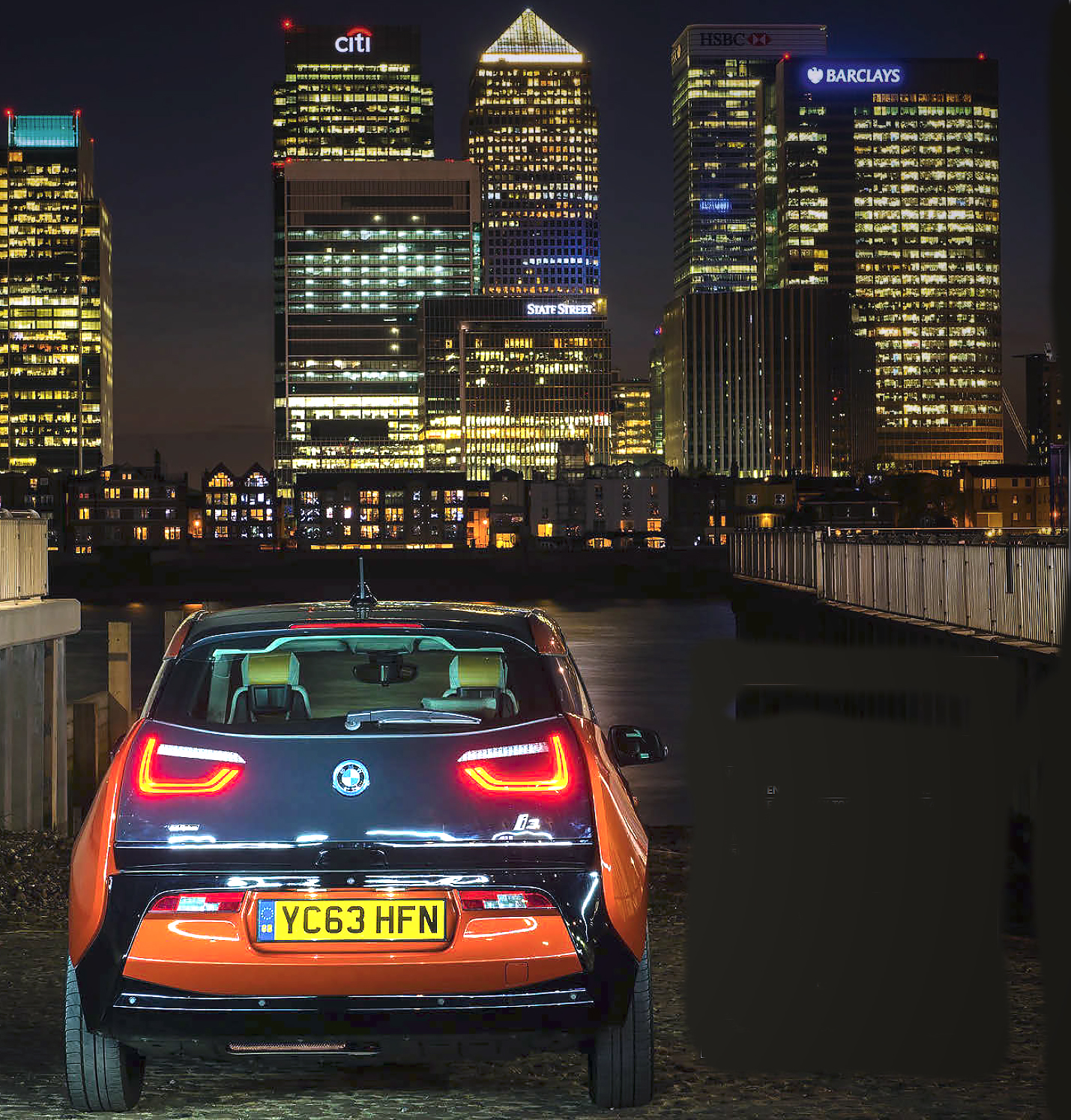
Overall I really enjoyed my week with the i3. Its performance is excellent, and far in excess of what I was expecting and I never once felt that I was going to get ‘range anxiety’ thanks to the back up of the RE motor. For the most part you’d probably never have to use it unless you regularly had to travel in excess of 80 miles between charges. There is a performance and weight penalty that comes with the RE version, but to be honest it’s still plenty fast enough for any motoring situation you’re likely to find yourself in and at 1315kg it’s still a useful 115kg less than an equivalently-sized BMW, such as a 118d F20.
You’d really need to spend even more time with an i3 to fully appreciate all of its talents, but as a town car it really has no peers. A tiny turning circle makes it supremely manoeuvrable and its point and squirt power delivery makes threading your way through cut and thrust traffic child’s play. It has genuinely green credentials all the way from its production methods to its clever use of materials and while it won’t meet everyone’s motoring needs it’s undoubtedly changed me from being a paid up member of the EV-phobic club to being one of its number one fans.
BMW i3 Ranae Extender
ELECTRIC MOTOR: Hybrid synchronous motor with integrated power electronics, charger and generator mode for recuperation
ELECTRIC MOTOR MAX POWER: 170hp
ELECTRIC MOTOR MAX TORQUE: 184lb ft
RANGE EXTENDER MOTOR: 647cc, two-cylinder
RANGE EXTENDER MAX POWER: 34hp @ 4300rpm
RANGE EXTENDER MAX TORQUE: 41lb ft @ 4300rpm
WEIGHT (DIN): 1315kg
0-62MPH: 7.9 seconds
50-75MPH: 5.5 seconds
TOP SPEED: 93mph
ECONOMY: 471mpg
EMISSIONS CO2: 13g/km
TRANSMISSION: Automatic, single-speed with fixed ratio
CLAIMED RANGE (Comfort Mode): 150-186 miles
CLAIMED RANGE (Eco Pro+): Up to 211 miles
RANGE (Comfort Mode – EU cycle): 105miles
CHARGING TIME (80 per cent charge): Three to seven hours depending on source
COST TO CHARGE: Approximately 2.4 pence per mile
PRICE (OTR): £28,830 (including £5000 government Plug-in Car Grant)





